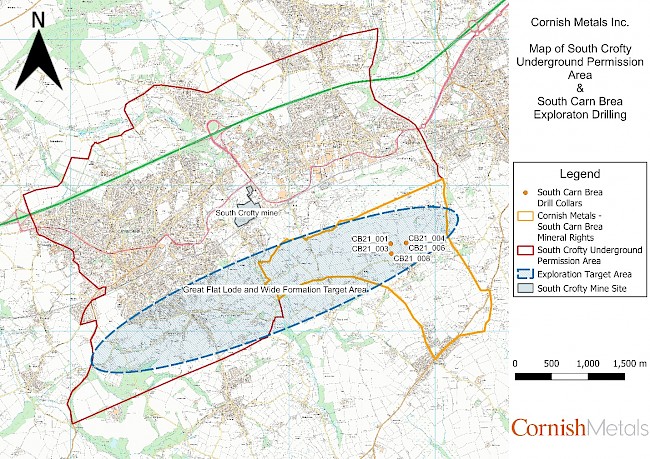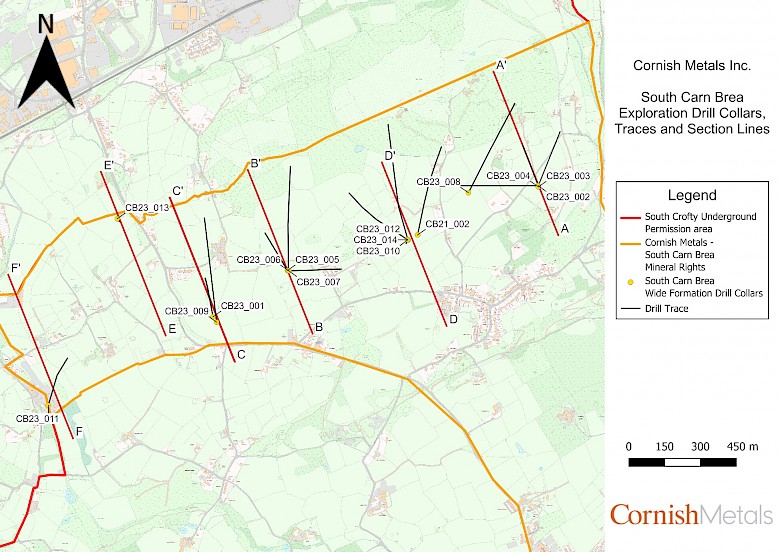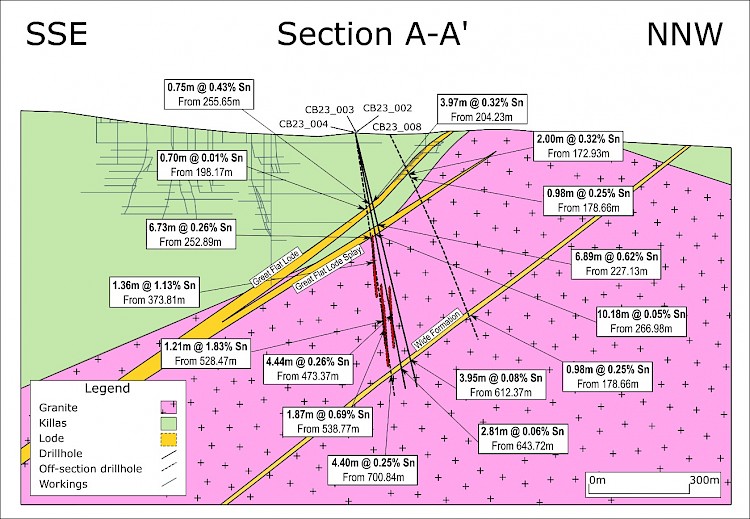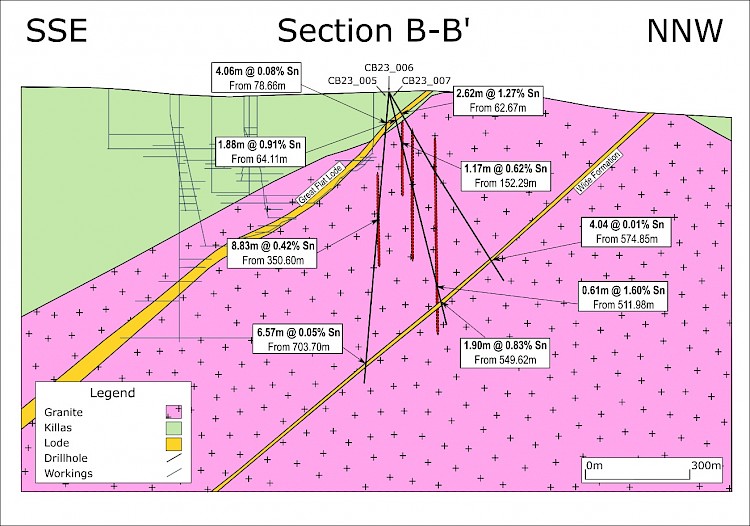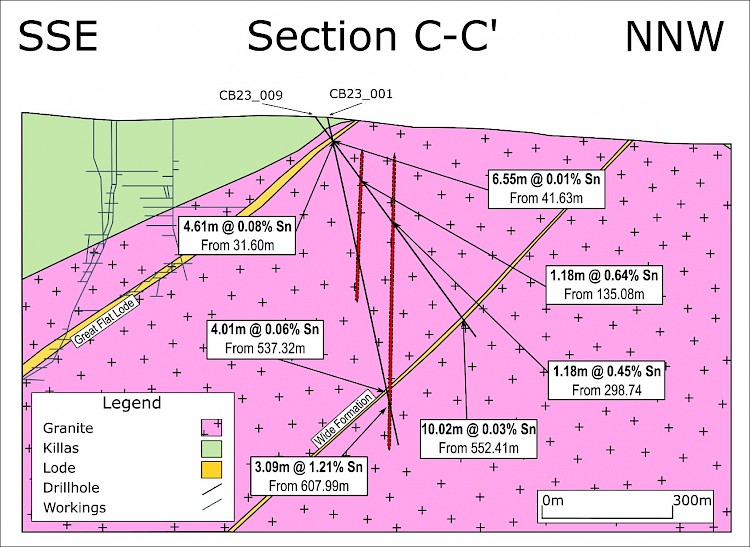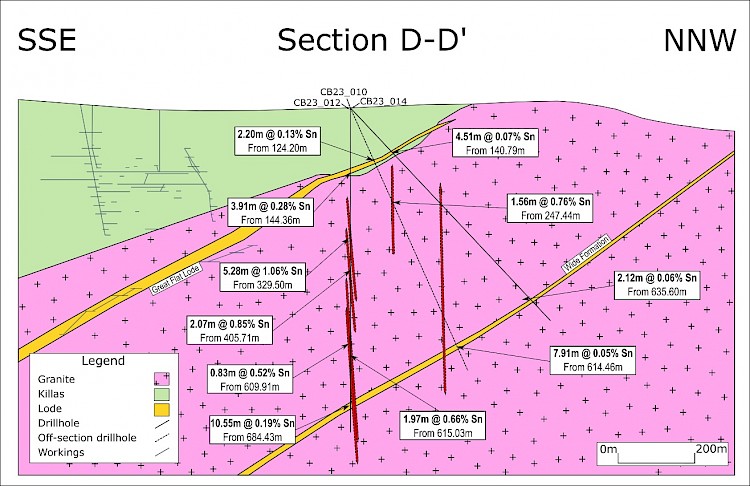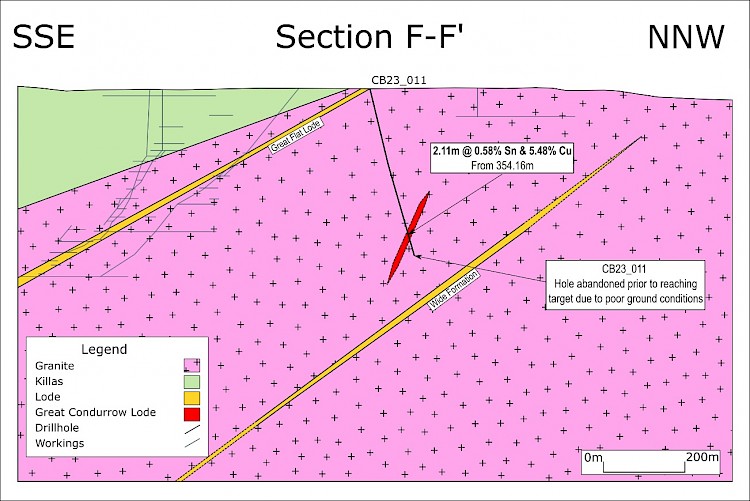Map showing the collar locations of the Carn Brea South drill holes in relation to the South Crofty underground permission area
Exploration Targets South of the South Crofty underground permission area
In early 2023, the Company reported results from eight drill holes drilled in the Carn Brea South exploration area, located along the southern boundary of the South Crofty underground permission area (see news release dated January 10, 2023). The discovery of this new high-grade zone of tin mineralisation in the middle of a historic mining district demonstrates the exploration potential of the region. The Great Flat Lode, which lies above the Wide Formation, was mined historically over a five km strike length, is a very compelling target to explore within and immediately adjacent to the South Crofty Underground Permission area. The shallow, high-grade tin intersects from the Great Flat Lode represent an opportunity to define nearby and near surface Mineral Resources to complement those Cornish Metals has already identified at South Crofty
The drill holes confirmed up-dip, near-surface, extensions of the historic Great Flat Lode and discovered tin mineralisation in a new target called the “Wide Formation”, inferred to lie parallel to, north of, and beneath the Great Flat Lode.
The Wide Formation
After discovering the new high-grade tin mineralisation target in the Wide Formation, located between and sub parallel to the past producing Great Flat Lode to the south, and the Dolcoath and South Crofty mines to the north, Cornish Metals commenced with a 14 hole/9,0000 metre drill programme and reported encouraging results in February and August 2024.
The results of the completed drilling programme (reported in In February 2024 and August 2024) validated the Wide Formation as a new, large-scale, tin-bearing exploration target that is potentially accessible from the underground workings at South Crofty. Mineralisation has been traced over a 2,500m extent, up to 800m down dip, and remains open along strike and to depth. Furthermore, in addition to the earlier discovery of the Great Flat Lode Splay and new ‘Dropper’ zones of high-grade tin mineralisation, the discovery of polymetallic tin and copper mineralisation within the interpreted extension of the Great Condurrow Mine’s Main Lode further demonstrates the exploration potential of the South Crofty area.
The numerous mineralised lodes and structures encountered during the programme have increased overall confidence in the Company’s exploration model and confirm the potential of systematic exploration drilling to make new discoveries and expand Mineral Resources within the South Crofty mine permission area and elsewhere within Cornish Metals’ extensive mineral rights in the region.
Map of the drillholes completed on the Wide Formation target
Highlights:
- Wide Formation structure has been confirmed over a strike length of over 2,500m and a downdip extent of at least 800m, with true thicknesses ranging from approximately 2m to 10m. The structure remains open at depth and along strike.
- Notable tin (“Sn”) intercepts within the Wide Formation (Figure 5) include:
- 10.55m grading 0.19% Sn including a zone of 1.49m grading 0.72% Sn in CB23_012
- Notable tin intercepts from the steeply-dipping, high-grade ‘Dropper’ zones identified primarily between the Great Flat Lode and the Wide Formation, including:
- 1.56m grading 0.76% Sn in CB23_010
- 2.07m grading 0.85% Sn in CB23_012
- 1.97m grading 0.66% Sn in CB23_012
- Notable tin and copper (“Cu”) intercepts from a new structure interpreted as the eastern extension to Great Condurrow Mine’s Main Lode (Figure 7), including:
- 2.11m grading 0.58% Sn and 5.48% Cu in CB23_011
Section A-A’ (looking west) showing CB23_002, CB23_003, CB23_004 and CB23_008
Section B-B’ (looking west) showing CB23_005, CB23_006 and CB23_007
Section C-C’ (looking west) showing CB23_001 and CB23_009
Section D-D’ (looking west) showing CB23_010, CB23_012 and CB23_014
Section E-E’ (looking west) showing CB23_013
Section F-F’ (looking west) showing CB23_011

